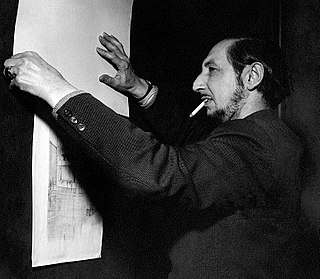
Carlo Scarpa was an Italian architect and designer. He was influenced by the materials, landscape, and history of Venetian culture, as well as that of Japan. Scarpa translated his interests in history, regionalism, invention, and the techniques of the artist and craftsman into ingenious glass and furniture design.

Pietro Longhi was a Venetian painter of contemporary genre scenes of life.

Lorenzo di Credi was an Italian Renaissance painter and sculptor best known for his paintings of religious subjects, and portraits. With some excursions to nearby cities, his whole life was spent in Florence. He is most famous for having worked in the studio of Andrea del Verrocchio at the same time as the young Leonardo da Vinci, who seems to have influenced his style considerably.
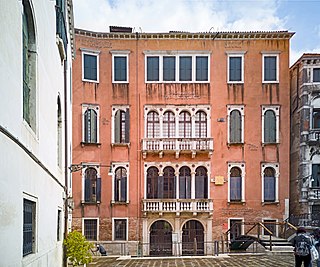
The Pinacoteca Querini Stampalia is an art collection and museum in Venice, Italy. Situated inside the Palazzo Querini Stampalia, in the sestiere of Castello, on the left bank of the Grand Canal, it includes famous paintings as a self- portrait and Adam and Eve by Palma Giovane, a Sacra Conversazione by Palma Vecchio and a Madonna and Child by Bernardo Strozzi. It also holds prized drawings by Giovanni Bellini, Raphael, Paolo Veronese, Titian, and Tintoretto.
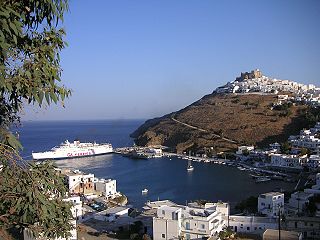
Astypalaia, is a Greek island with 1,334 residents. It belongs to the Dodecanese, an archipelago of fifteen major islands in the southeastern Aegean Sea. However, many scholars recognize Astypalaia as an extension of the Cyclades, as many cultural and ecological components of the island are more indicative of the Cyclades rather than the Dodecanese.
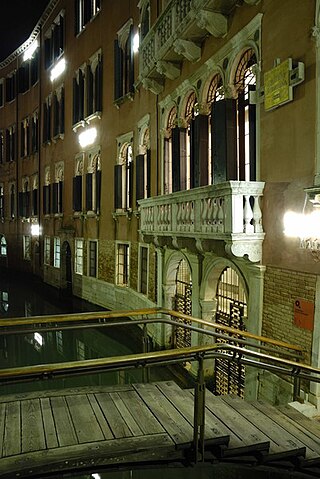
The Fondazione Querini Stampalia is a cultural institution in Venice, Italy, founded in 1869 at the behest of the last descendant of the Venetian Querini Stampalia family, Conte Giovanni Querini. Architect Carlo Scarpa designed interior, exterior, and garden elements and spaces on the ground floor of the historic building.
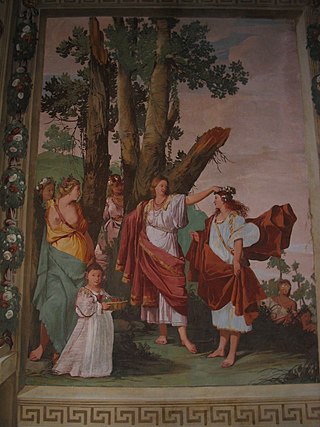
Giulio Carpioni was an Italian painter and etcher of the early Baroque era.
There are several entries linked with the family name of Querini Stampalia, a branch of the Querini:

Luigi De Giudici was an Italian painter of the Venetian anti-academic movement in the first years of the twentieth century. His works were exhibited at Ca' Pesaro between 1912 and 1920 and at the International Exposition of Paris (1937).

The Presentation at the Temple is a painting of the Presentation of Jesus at the Temple by the Italian master Giovanni Bellini, dating to c. 1460. It is housed in the Fondazione Querini Stampalia, in Venice, Italy.

Ferruccio Bortoluzzi was an Italian modern painter, he was one of the founders of the Centro di Unità della Cultura L'Arco together with venetian artists and writers.
Umberto Ongania was an Italian painter, mainly of vedute of his native city.
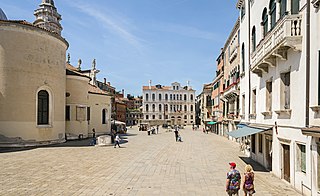
Campo Santa Maria Formosa is a city square in the Castello district of Venice, Italy.
EdmondoBacci was an Italian painter born in Venice. He is best known for a series of paintings called Avvenimenti. Bacci studied at the Accademia di Belle Arti di Venezia and was a member of the artist's Movimento Spaziale, a group founded by Lucio Fontana. He began exhibiting internationally in 1956. Bacci took part in the Venice Biennale several times, in 1958 his works were accorded a separate room. From the mid 1950s onwards he was promoted and supported by Peggy Guggenheim.
Ferdinando Ongania (1842-1911) was a Venetian publisher and bookseller best known for publishing the monumental book Basilica San Marco. Ongania published more than 170 books, mainly about Venice. He was particularly significant for using the latest photographic techniques to create facsimile editions and reproductions of great Venetian artworks. In particular, his heliographic prints were remarkable for their clarity. He published out of his antique shop and gallery on Piazza San Marco, which catered to an international clientele.

Michele Fabris was a Baroque sculptor, born in Hungary, but mainly active in Venice and Padua. A series of busts at the Querini Stampalia Museum, previously attributed to Orazio Marinali, are now attributed to him. Due to his Hungarian origins, he is also referred to as l'Ongaro.
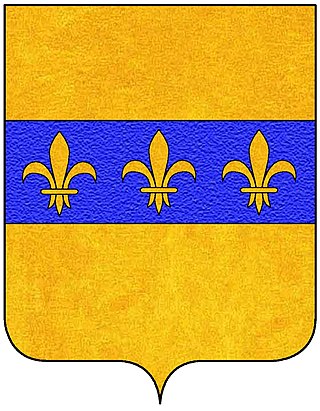
The Querini family or Quirini was an old Venetian patrician family. They claimed an ancient Roman heritage, but their traceable history goes back to the 11th century. The family divided into many branches.
This page is based on this
Wikipedia article Text is available under the
CC BY-SA 4.0 license; additional terms may apply.
Images, videos and audio are available under their respective licenses.













